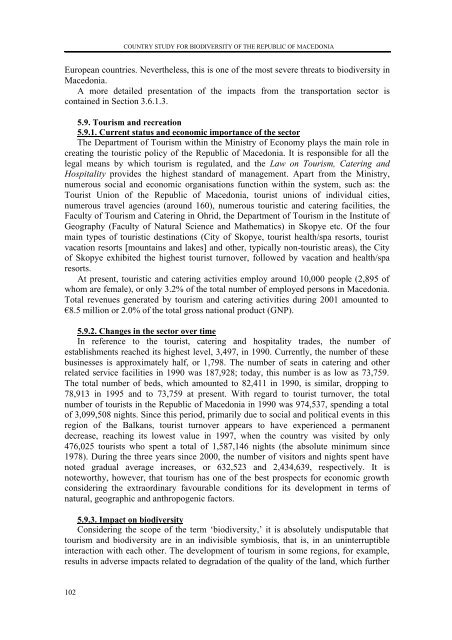English - Convention on Biological Diversity
English - Convention on Biological Diversity
English - Convention on Biological Diversity
You also want an ePaper? Increase the reach of your titles
YUMPU automatically turns print PDFs into web optimized ePapers that Google loves.
102<br />
COUNTRY STUDY FOR BIODIVERSITY OF THE REPUBLIC OF MACEDONIA<br />
European countries. Nevertheless, this is <strong>on</strong>e of the most severe threats to biodiversity in<br />
Maced<strong>on</strong>ia.<br />
A more detailed presentati<strong>on</strong> of the impacts from the transportati<strong>on</strong> sector is<br />
c<strong>on</strong>tained in Secti<strong>on</strong> 3.6.1.3.<br />
5.9. Tourism and recreati<strong>on</strong><br />
5.9.1. Current status and ec<strong>on</strong>omic importance of the sector<br />
The Department of Tourism within the Ministry of Ec<strong>on</strong>omy plays the main role in<br />
creating the touristic policy of the Republic of Maced<strong>on</strong>ia. It is resp<strong>on</strong>sible for all the<br />
legal means by which tourism is regulated, and the Law <strong>on</strong> Tourism, Catering and<br />
Hospitality provides the highest standard of management. Apart from the Ministry,<br />
numerous social and ec<strong>on</strong>omic organisati<strong>on</strong>s functi<strong>on</strong> within the system, such as: the<br />
Tourist Uni<strong>on</strong> of the Republic of Maced<strong>on</strong>ia, tourist uni<strong>on</strong>s of individual cities,<br />
numerous travel agencies (around 160), numerous touristic and catering facilities, the<br />
Faculty of Tourism and Catering in Ohrid, the Department of Tourism in the Institute of<br />
Geography (Faculty of Natural Science and Mathematics) in Skopye etc. Of the four<br />
main types of touristic destinati<strong>on</strong>s (City of Skopye, tourist health/spa resorts, tourist<br />
vacati<strong>on</strong> resorts [mountains and lakes] and other, typically n<strong>on</strong>-touristic areas), the City<br />
of Skopye exhibited the highest tourist turnover, followed by vacati<strong>on</strong> and health/spa<br />
resorts.<br />
At present, touristic and catering activities employ around 10,000 people (2,895 of<br />
whom are female), or <strong>on</strong>ly 3.2% of the total number of employed pers<strong>on</strong>s in Maced<strong>on</strong>ia.<br />
Total revenues generated by tourism and catering activities during 2001 amounted to<br />
€8.5 milli<strong>on</strong> or 2.0% of the total gross nati<strong>on</strong>al product (GNP).<br />
5.9.2. Changes in the sector over time<br />
In reference to the tourist, catering and hospitality trades, the number of<br />
establishments reached its highest level, 3,497, in 1990. Currently, the number of these<br />
businesses is approximately half, or 1,798. The number of seats in catering and other<br />
related service facilities in 1990 was 187,928; today, this number is as low as 73,759.<br />
The total number of beds, which amounted to 82,411 in 1990, is similar, dropping to<br />
78,913 in 1995 and to 73,759 at present. With regard to tourist turnover, the total<br />
number of tourists in the Republic of Maced<strong>on</strong>ia in 1990 was 974,537, spending a total<br />
of 3,099,508 nights. Since this period, primarily due to social and political events in this<br />
regi<strong>on</strong> of the Balkans, tourist turnover appears to have experienced a permanent<br />
decrease, reaching its lowest value in 1997, when the country was visited by <strong>on</strong>ly<br />
476,025 tourists who spent a total of 1,587,146 nights (the absolute minimum since<br />
1978). During the three years since 2000, the number of visitors and nights spent have<br />
noted gradual average increases, or 632,523 and 2,434,639, respectively. It is<br />
noteworthy, however, that tourism has <strong>on</strong>e of the best prospects for ec<strong>on</strong>omic growth<br />
c<strong>on</strong>sidering the extraordinary favourable c<strong>on</strong>diti<strong>on</strong>s for its development in terms of<br />
natural, geographic and anthropogenic factors.<br />
5.9.3. Impact <strong>on</strong> biodiversity<br />
C<strong>on</strong>sidering the scope of the term ‘biodiversity,’ it is absolutely undisputable that<br />
tourism and biodiversity are in an indivisible symbiosis, that is, in an uninterruptible<br />
interacti<strong>on</strong> with each other. The development of tourism in some regi<strong>on</strong>s, for example,<br />
results in adverse impacts related to degradati<strong>on</strong> of the quality of the land, which further
















